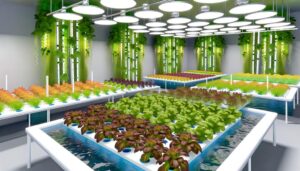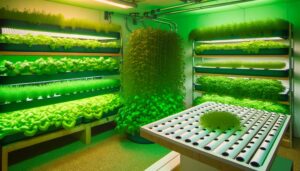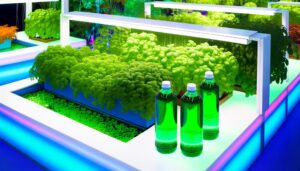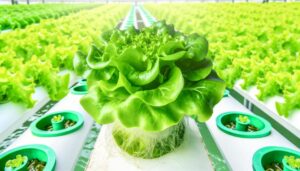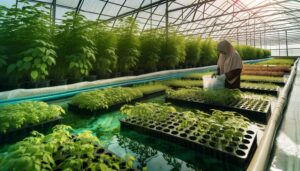What Do You Need for Hydroponics
To start a hydroponic garden successfully, we need a precise combination of hydroponic systems, such as DWC or NFT, tailored for nutrient delivery. Appropriate growing mediums like Rockwool or clay pellets guarantee ideal root support.
We rely on balanced nutrient solutions rich in macronutrients (N, P, K) and micronutrients (Fe, Mn, Zn) for plant growth. Specialized grow lights, such as LEDs, provide the necessary light spectrum.
Accurate pH and EC meters are essential for monitoring nutrient uptake, and efficient water pumps and air stones maintain proper circulation and oxygenation. To fully enhance our setup, understanding each component's role will provide deeper insights.

Key Takeaways
- Select a hydroponic system: options include DWC, NFT, ebb and flow, aeroponics, drip, and wick systems.
- Choose a growing medium: options like rockwool, clay pellets, coconut coir, perlite, or peat moss.
- Use balanced nutrient solutions: ensure essential macronutrients (N, P, K) and micronutrients (Fe, Mn, Zn) are present.
- Install appropriate grow lights: consider LED, HID, fluorescent, plasma, or incandescent based on energy efficiency and plant needs.
Hydroponic Systems
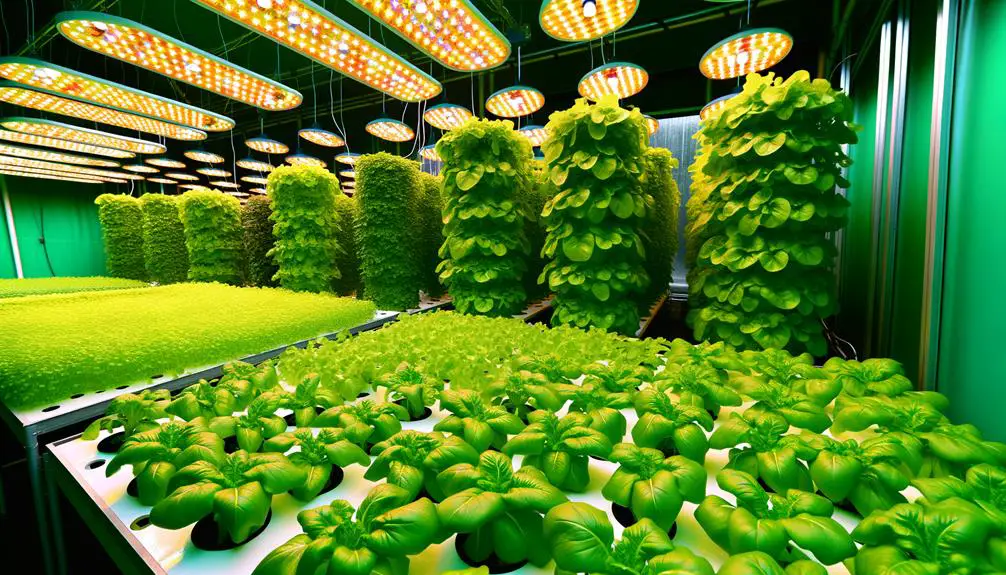
Hydroponic systems, which can be categorized into six primary types, provide the framework for soilless cultivation by delivering nutrients and water directly to plant roots. These types include Deep Water Culture (DWC), Nutrient Film Technique (NFT), Ebb and Flow (Flood and Drain), Aeroponics, Drip Systems, and Wick Systems.
Each system has unique mechanisms for nutrient delivery and oxygenation. For instance, DWC suspends roots in nutrient-rich water, while NFT uses a thin film of nutrients flowing over the roots.
Aeroponics, the most advanced, mists nutrients directly onto roots, maximizing oxygen exposure.
Growing Mediums
Let's examine the various types of growing mediums essential to hydroponics.
We'll analyze the benefits and drawbacks of each, providing a clear understanding of their applications.
Types of Growing Mediums
When selecting growing mediums, we must carefully evaluate their water retention, aeration properties, and compatibility with different hydroponic systems. Each medium offers distinct characteristics that influence plant growth.
Let's examine some popular options:
- Rockwool: Known for excellent water retention and aeration, ideal for seed germination and various hydroponic setups.
- Clay Pellets: Provide superior drainage and stability, making them suitable for ebb and flow systems.
- Coconut Coir: High water retention with good aeration, eco-friendly and versatile for diverse systems.
Benefits and Drawbacks
Understanding the benefits and drawbacks of each growing medium helps us optimize plant health and system efficiency in hydroponics.
Let's analyze some key factors.
Water retention is critical; too much can cause root rot, while too little may stress plants.
Aeration guarantees roots receive oxygen; poor aeration leads to suffocation.
pH stability affects nutrient uptake; unstable mediums require constant monitoring.
Cost-effectiveness impacts scalability; high-cost mediums may limit large-scale operations.
Reusability influences sustainability and operational costs; non-reusable mediums generate more waste.
Finally, the medium's weight affects system design; heavy mediums require robust structures, increasing setup costs.
Popular Mediums Explained
In hydroponics, choosing the right growing medium is essential for enhancing plant health and system performance. Each medium offers unique properties that can influence water retention, aeration, and nutrient delivery.
Let's explore some popular options:
- Rockwool: Excellent water retention and aeration, but requires pH adjustment.
- Coco Coir: Sustainable and retains moisture well, but may need buffering to remove excess salts.
- Perlite: Promotes aeration and drainage, ideal for systems requiring frequent watering.
Selecting the proper medium is pivotal for achieving desired outcomes in our hydroponic systems.
Understanding these mediums' specific characteristics allows us to tailor our approach, ensuring the best plant growth and system efficiency.
Nutrient Solutions
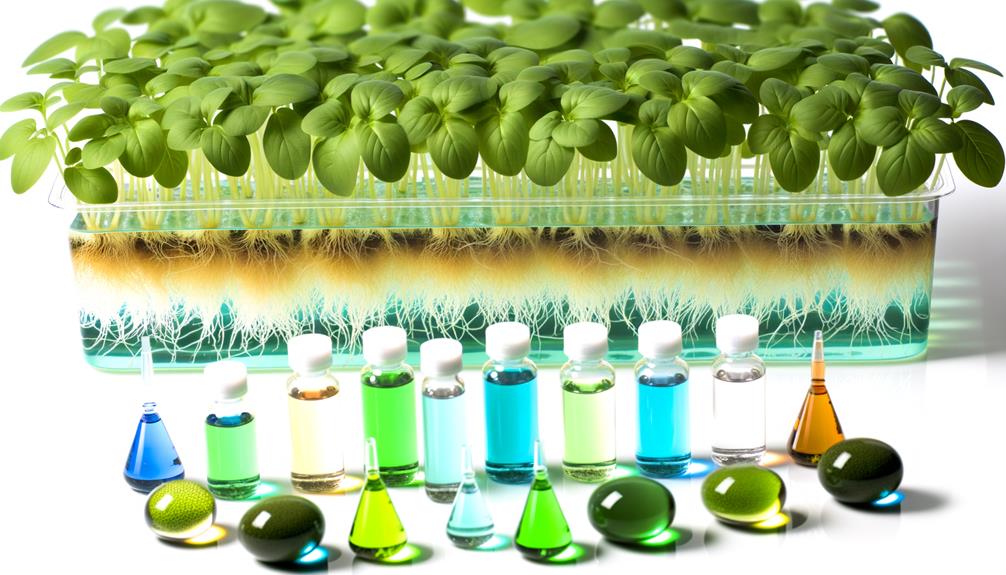
Ideal nutrient solutions form the backbone of successful hydroponic systems, providing plants with the precise minerals and elements they need for robust growth.
We must guarantee that our nutrient solutions are meticulously balanced, incorporating essential macronutrients like nitrogen (N), phosphorus (P), and potassium (K), as well as crucial micronutrients such as iron (Fe), manganese (Mn), and zinc (Zn).
Grow Lights
Let's explore the critical aspects of grow lights, starting with the different types available and their specific applications.
We'll analyze the importance of light spectrum in plant growth, focusing on how various wavelengths affect photosynthesis.
Types of Grow Lights
Selecting the right grow lights is essential for enhancing plant growth in hydroponic systems. We need to evaluate various types, each offering unique benefits and efficiencies.
Common choices include:
- LED (Light Emitting Diodes): Energy-efficient, long lifespan, customizable spectrums.
- HID (High-Intensity Discharge): Includes MH (Metal Halide) and HPS (High Pressure Sodium); high light output, suitable for larger setups.
- Fluorescent: T5 and CFL (Compact Fluorescent Lamps); lower heat output, good for small-scale or seedling growth.
Analyzing these options, we can match our specific hydroponic needs with the best grow light type.
Each type presents trade-offs regarding energy consumption, heat emission, and light spectrum, which we must carefully balance to maximize growth efficiency and innovation in our hydroponic systems.
Light Spectrum Importance
Understanding the importance of light spectrum is vital for optimizing plant growth in hydroponic systems. We need to utilize specific wavelengths to target various growth stages effectively. Blue light (400-500 nm) promotes vegetative growth, while red light (600-700 nm) enhances flowering and fruiting. Balancing these spectrums guarantees that our plants receive the appropriate signals for each developmental phase.
Here's a quick reference table to help visualize the impact:
| Light Spectrum (nm) | Plant Growth Effect |
|---|---|
| 400-500 | Vegetative growth (leafy greens) |
| 500-600 | Limited impact |
| 600-700 | Flowering and fruiting |
| 700-800 | Far-red, influences flowering |
| Full Spectrum | Balanced growth |
Harnessing this knowledge allows us to innovate and tailor our hydroponic systems for maximum efficiency.
Light Placement Tips
Positioning our grow lights correctly is essential for guaranteeing even light distribution and optimal plant growth in hydroponic systems. To achieve ideal results, we must consider several factors:
- Height: Adjust the height of the grow lights to maintain an ideal distance from the plant canopy. Generally, 12-18 inches is effective for most LED grow lights.
- Coverage: Confirm the light footprint covers all plants uniformly, avoiding shaded areas that can hinder growth.
- Angle: Position lights at angles that maximize penetration, especially for dense canopies.
Ph and EC Meters
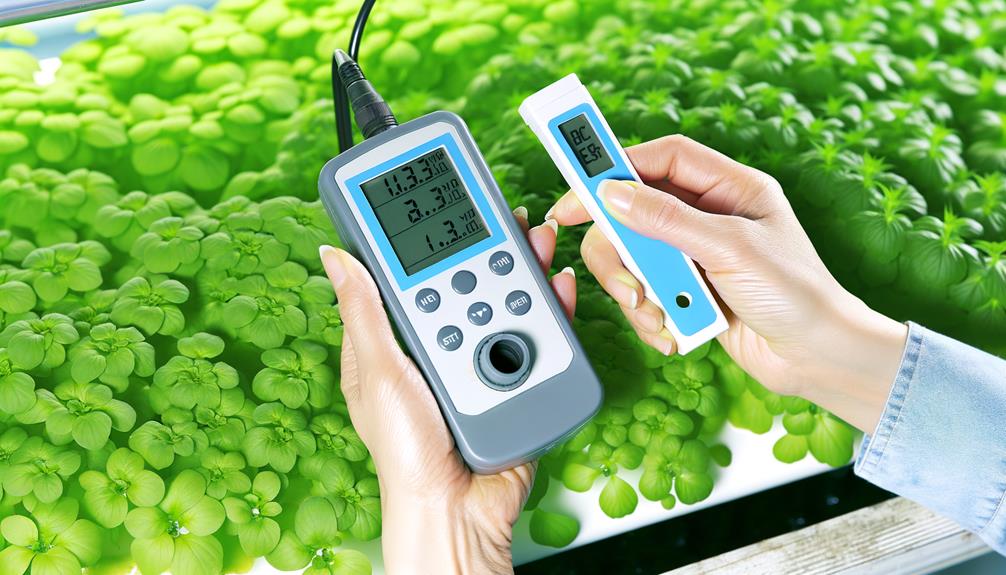
To maintain ideal nutrient levels in our hydroponic systems, we must regularly measure and adjust the pH and electrical conductivity (EC) using precise meters.
Accurate pH measurement guarantees nutrient availability and suitable plant growth. We aim for a pH range of 5.5 to 6.5, adjusting with pH up or down solutions as necessary.
EC meters, on the other hand, measure the concentration of dissolved salts, guiding us in nutrient solution preparation. Ideal EC levels vary by plant species but typically range from 1.2 to 2.5 mS/cm.
Regular monitoring prevents nutrient imbalances and promotes efficient uptake. By leveraging these tools, we maintain a stable and productive hydroponic environment, driving innovation in controlled-environment agriculture.
Water Pumps and Air Stones
After confirming ideal nutrient levels with pH and EC meters, we turn our attention to water pumps and air stones, which are essential for maintaining proper water circulation and aeration in hydroponic systems.
Efficient water circulation guarantees even distribution of nutrients and oxygen, which is vital for root health and plant growth. Air stones, on the other hand, diffuse air into the water, increasing oxygen solubility.
Key considerations include:
- Pump Capacity: Verify the pump can handle the system's water volume.
- Air Stone Size: Larger air stones provide better oxygen diffusion.
- Flow Rate: Adjust the flow rate to avoid root damage.
Conclusion
In the ever-evolving world of hydroponics, we've explored the essentials: hydroponic systems, growing mediums, nutrient solutions, grow lights, pH and EC meters, and water pumps and air stones.
With these tools at our disposal, we can gently usher our plants towards their ideal growth potential.
By mastering these components, we're not just nurturing plants; we're cultivating a future where sustainability and innovation bloom.
Let's embrace this green revolution with both hands, shall we?

